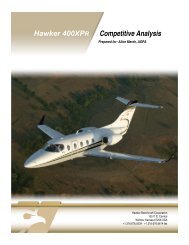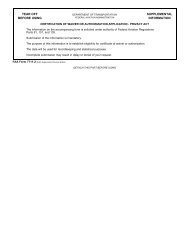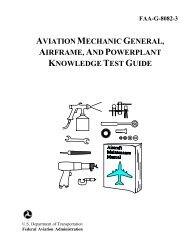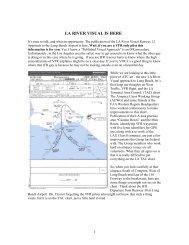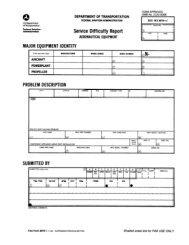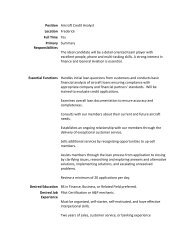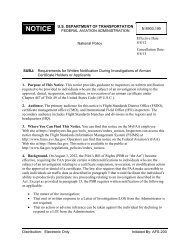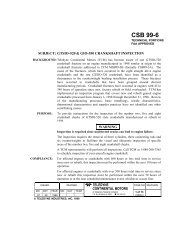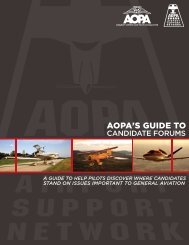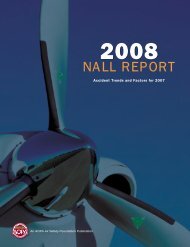FAA Order 8300.10, 8400.10, 8700.10
FAA Order 8300.10, 8400.10, 8700.10
FAA Order 8300.10, 8400.10, 8700.10
You also want an ePaper? Increase the reach of your titles
YUMPU automatically turns print PDFs into web optimized ePapers that Google loves.
ORDER: <strong>8300.10</strong>, <strong>8400.10</strong>, and 8700.1<br />
APPENDIX: 3<br />
BULLETIN TYPE:<br />
Joint Handbook Bulletin for Air Transportation<br />
(HBAT), Airworthiness (HBAW), and General<br />
Aviation (HBGA)<br />
BULLETIN NUMBER: HBAT 99-10A, HBAW 99-12A, AND HBGA 99-14A<br />
BULLETIN TITLE:<br />
Streamlined Administrative Action Process<br />
EFFECTIVE DATE: 08-03-99<br />
TRACKING NUMBER: GAO Report # RCED-98-6<br />
--------------------------------------------------------------------<br />
NOTE: THIS BULLETIN REQUIRES PTRS INPUT. SEE PARAGRAPH 5.<br />
--------------------------------------------------------------------<br />
NOTE: THIS IS THE CORRECT VERSION OF THIS BULLETIN. Any previous<br />
version without this note is not valid. There is no substantive<br />
change in the bulletin, only minor editorial corrections.<br />
1. PURPOSE. This handbook bulletin provides information pertaining<br />
to the processing of administrative enforcement actions.<br />
2. BACKGROUND. Federal Aviation Administration (<strong>FAA</strong>) inspectors<br />
have expressed concern that the current process for administrative<br />
action is burdensome and should be streamlined. A number of reports<br />
and studies during the period from 1989 to the present have<br />
consistently made the recommendation that the <strong>FAA</strong> streamline its<br />
enforcement program by eliminating several procedural steps it takes<br />
to issue administrative enforcement actions that appear to be simple<br />
and factually straightforward.<br />
A. In 1998, General Accounting Office (GAO) Report # RCED-98-6<br />
titled “Aviation Safety: Weaknesses in Inspection and Enforcement<br />
Limit <strong>FAA</strong> in Identifying and Responding to Risks,” reported that<br />
inspectors are underreporting safety violations. The report stated<br />
that although <strong>FAA</strong> guidance requires inspectors to enter all observed<br />
problems or violations, 35% of Flight Standards inspectors said they<br />
reported half or fewer of the problems or violations they observed<br />
during inspections in fiscal year 1996.<br />
B. In December 1998 the Administrator announced an initiative to<br />
implement a new “streamlined administrative action process” that will<br />
reduce paperwork and shorten the time it takes to resolve certain<br />
violations that do not pose a serious threat to aviation safety. The<br />
new process will provide inspectors with a more efficient way to<br />
resolve straightforward violations that do not warrant legal<br />
1
enforcement action, and will address their concerns that the current<br />
process for administrative action is burdensome and should be<br />
streamlined.<br />
C. This bulletin implements the Administrator’s initiative by<br />
streamlining the internal processing of administrative actions<br />
through the use of a job aid and enhanced automation. The new<br />
process will facilitate the reporting of alleged violations and<br />
reduce the time it takes to issue administrative actions. This<br />
bulletin supplements, but does not replace, the current guidance for<br />
administrative action that is found in chapter 11 of <strong>FAA</strong><br />
<strong>Order</strong> 2150.3A, Compliance and Enforcement Program.<br />
3. GUIDANCE.<br />
A. Effective immediately inspectors may use the process outlined<br />
in this bulletin to address alleged violations that do not require<br />
extensive investigation or warrant legal enforcement action. The job<br />
aid (Figure 1) and automated issuance of a warning notice or letter<br />
of correction provide another means of processing routine<br />
administrative enforcement actions. They do not replace the more<br />
formal process for taking administrative action. The formal process<br />
is described in chapter 11 of <strong>FAA</strong> <strong>Order</strong> 2150.3A. The job aid may not<br />
be used for remedial training, self-disclosures, or cases where<br />
further corrective action must be taken.<br />
B. The job aid may be used when the alleged violation does not<br />
require extensive investigation. For example, when inspectors<br />
personally observe an alleged violation or when evidence is readily<br />
available, the job aid may be used to document the facts and<br />
circumstances of the alleged violation. In these instances,<br />
inspectors must speak with alleged violators about the noncompliance,<br />
advising them why their act or omission resulted in a regulatory<br />
violation and that enforcement action will be taken. A copy of the<br />
completed job aid will NOT be provided to the alleged violator. The<br />
completed job aid is an internal document that is used to facilitate<br />
the entry of data into the Enforcement Information System (EIS).<br />
C. Before the information concerning the alleged violation is<br />
entered into the EIS, inspectors must determine that administrative<br />
action is appropriate under paragraph 205 of <strong>Order</strong> 2150.3A. This<br />
includes reviewing appropriate databases to ascertain the compliance<br />
history of the alleged violator. An Enforcement Investigative Report<br />
(EIR) number must be entered on the job aid.<br />
D. Administrative personnel will enter the information on the job<br />
aid into the EIS. Based on the information entered into the EIS a<br />
warning notice or letter of correction (see Figures 2 and 3) will be<br />
generated and issued from Flight Standard Service, Regulatory Support<br />
Division (AFS-600).<br />
2
E. If the inspector determines that more than minimal<br />
investigation is required for the alleged violation and<br />
administrative action is appropriate under paragraph 205 of <strong>FAA</strong><br />
<strong>Order</strong> 2150.3A, then formal procedures in chapter 11 of that order<br />
should be used. Inspectors should use such procedures when they<br />
determine that a letter of investigation should be sent to the<br />
alleged violator.<br />
F. A letter of investigation will not be issued when using the job<br />
aid, as solicitation of additional correspondence from the alleged<br />
violator should not be necessary. In accordance with the guidance in<br />
chapter 2 of <strong>Order</strong> 2150.3A alleged violations must be substantiated.<br />
Items of proof, however, need not be gathered unless unusual<br />
circumstances are present. The EIR for these cases will consist only<br />
of a completed job aid.<br />
G. In the event an administrative action is withdrawn and no<br />
action is determined to be appropriate, the alleged violator should<br />
be notified of such in writing by the investigating office.<br />
Appropriate field office and regional office entries will be made in<br />
the EIS to close the case in accordance with <strong>Order</strong> 2150.3A.<br />
H. The guidance in this bulletin supersedes existing guidance in<br />
<strong>FAA</strong> <strong>Order</strong> 8700.1, General Aviation Operations Inspector’s Handbook,<br />
<strong>FAA</strong> <strong>Order</strong> <strong>8300.10</strong>, Airworthiness Inspector’s Handbook, and <strong>FAA</strong><br />
<strong>Order</strong> <strong>8400.10</strong>, Air Transportation Inspector’s Handbook when the job<br />
aid is used for administrative enforcement action.<br />
4. ACTION.<br />
A. Field Office Action.<br />
(1) Inspector. After deciding on the appropriate action<br />
(Warning Notice or Letter of Correction), inspectors must complete<br />
the appropriate alleged violator identification, aircraft, and<br />
violation data sections of the job aid using the instructions<br />
depicted in Figure 1.<br />
(2) Data Entry. Personnel will ensure an EIR number is recorded<br />
on the job aid and enter the job aid information into the EIS. The<br />
only sanction codes available for job aids are 15 and 16.<br />
(3) Management Review. Supervisors shall review job aids and<br />
periodic management reports to ensure proper form completion, timely<br />
processing, and appropriateness in meeting compliance end enforcement<br />
goals and objectives.<br />
(4) Record Retention. Completed job aids shall be filed in<br />
accordance with local office policy and retained in accordance with<br />
the <strong>FAA</strong> expunction policy and records retention <strong>FAA</strong> <strong>Order</strong> 1350.15;<br />
3
Records Organization, Transfer, and Destruction Standards.<br />
B. AFS-600 Action.<br />
(1) Issuance of Automated Letter. AFS-600 will issue an<br />
automated warning notice or letter of correction based on data<br />
entered into the EIS mainframe. This notice or letter will normally<br />
be issued within 3 working days after EIS entry.<br />
(2) Data Quality Assurance. Enforcement records generated by<br />
the job aid that cannot be processed due to data entry errors will be<br />
annotated as such and returned to the originating office for<br />
correction.<br />
(3) Management Reports. Standard reports will be available to<br />
both district and regional offices to provide feedback to management<br />
on the use of the streamlined administrative action process.<br />
C. Regional Office Action. The appropriate regional division<br />
shall review the standard reports for internal purposes.<br />
5. PROGRAM TRACKING AND REPORTING SYSTEM (PTRS). Aviation safety<br />
inspectors shall make a PTRS entry to record their actions directed<br />
by this bulletin. The PTRS entry shall be listed as activity<br />
code 1733, 3732, 5732, as appropriate. Inspectors shall use the<br />
comments section to record observations and actions taken.<br />
6. INQUIRIES. This bulletin was developed by the Compliance and<br />
Review Team. Questions regarding this bulletin should be directed to<br />
Mark D. Weitzenhoffer, ANM-230, (425)227-2261.<br />
7. LOCATION. The material in this bulletin will remain in effect<br />
until it is incorporated into <strong>FAA</strong> <strong>Order</strong> <strong>8400.10</strong>, Air Transportation<br />
Inspector’s Handbook, <strong>FAA</strong> <strong>Order</strong> <strong>8300.10</strong>, Airworthiness Inspector’s<br />
Handbook, and <strong>FAA</strong> <strong>Order</strong> 8700.1, General Aviation Operations<br />
Inspector’s Handbook.<br />
/s/<br />
L. Nicholas Lacey<br />
Director, Flight Standards Service, AFS-1<br />
4
Figure 1. Job Aid<br />
This is a .pdf file. Acrobat Reader is required to view and<br />
print this job aid. If you do not have Acrobat Reader, it can be<br />
downloaded free from www.adobe.com.<br />
Acrobat Document<br />
5
Figure 2. Warning Notice<br />
U.S. Department<br />
of Transportation<br />
Federal Aviation<br />
Administration<br />
Anytown FSDO<br />
123 Whispering Lane<br />
Anytown, US 54321<br />
(101) 555-1234<br />
July 29, 1999<br />
Jonathan Aviator<br />
123 Golden Dr.<br />
Anytown, US 54321<br />
Warning Notice<br />
File Number: 1999DC050024<br />
Reporting Inspector: Mary Smith<br />
This notice cites an alleged violation(s) of the following<br />
Title 14 Code of Federal Regulations (14 CFR) sections that<br />
occurred in Oklahoma City, OK on July 29, 1999.<br />
Cite:<br />
14 CFR §121.542B Flight Crewmember Failed To Maintain Sterile Cockpit<br />
The determination to issue this notice is based on the facts and circumstances surrounding the<br />
alleged violation(s) that were discussed with you by the reporting inspector. If, within 30 calendar<br />
days of the date of this letter, you wish to add additional pertinent information in explanation or<br />
mitigation, write to:<br />
Manager<br />
Anytown FSDO<br />
123 Whispering Lane<br />
Anytown, US 54321<br />
It has been determined that this matter does not warrant legal enforcement action; however, the alleged violation(s)<br />
will be made a matter of record. Records concerning individuals will be expunged 2 years after the date of issuance.<br />
Your future compliance with the regulations is expected.<br />
Additional Information On Back
Figure 2. Warning Notice<br />
PRIVACY ACT NOTICE<br />
This notice is provided in accordance with Section (e)(3) of the Privacy Act, 5 U.S.C. 552a(e)(3).<br />
A. Authority: This information is solicited pursuant to 49 U.S.C. 40113(a) and the regulations issued thereunder<br />
codified in Title 14 of the Code of Federal Regulations, part 13. Submission of information is voluntary.<br />
B. Principal Purposes:<br />
1. To make a record of the circumstances that are the subject of this warning notice or letter of correction.<br />
2. To assist us in contacting you regarding this enforcement case.<br />
C. Routine Uses: Records from this system of records may be disclosed in accordance with the following routine<br />
uses that appear in the System of Records No. DOT/<strong>FAA</strong> 847, General Air Transportation Records on Individuals,<br />
DOT/<strong>FAA</strong>:<br />
1. To provide basic airmen certification and qualification information to the public upon request.<br />
2. To disclose information to the National Transportation Safety Board (NTSB) in connection with its<br />
investigation responsibilities.<br />
3. To provide information about airmen to Federal, state, and local law enforcement agencies when engaged in<br />
the investigation and apprehension of drug law violators.<br />
4. To provide information about enforcement actions arising out of violations of the Federal Aviation<br />
Regulations to government agencies, the aviation industry, and the public upon request.<br />
5. To disclose information to another Federal agency, or to a court or an administrative tribunal, when the<br />
Government or one of its agencies is a party to a judicial proceeding before the court or involved in administrative<br />
proceedings before the tribunal.<br />
D. Effect of failure to respond: Failure to provide information requested may preclude us from closing this matter<br />
with a warning notice or letter of correction at this time. In addition, there may be delay in contacting you regarding<br />
this enforcement case if necessary.<br />
ABOUT ADMINISTRATIVE ACTION<br />
Warning Notices and Letters of Correction are Administrative Actions. Administrative Action is authorized by<br />
14 CFR part 13 and is routinely used for minor infractions instead of legal enforcement; (e.g., suspensions,<br />
revocations, or fines).<br />
Legal Effect. Neither a Warning Notice nor a Letter of Correction constitutes a finding of violation and, therefore,<br />
notice and hearing are not required.<br />
Recourse Available. The determination to issue the notice or letter is based on the facts and circumstances<br />
surrounding the alleged violation(s) including any information you provided. An airman or company can introduce<br />
additional pertinent information in explanation or mitigation by writing to the reporting inspector or district office<br />
manager within 30 calendar days of the date of the notice or letter. Administrative Actions can be withdrawn.<br />
Release of Information. When the <strong>FAA</strong> responds to Pilot Records Improvement Act (PRIA) requests, ONLY final<br />
legal enforcement actions resulting in a finding of violation are released. Enforcement database information<br />
pertaining to No Actions, Administrative Actions, or Legal Actions in process or under appeal, are NOT released<br />
under PRIA. However, administrative action information may be released pursuant to a Freedom of Information Act<br />
(FOIA)<br />
request.
Figure 3. Letter of Correction<br />
U.S. Department<br />
of Transportation<br />
Federal Aviation<br />
Administration<br />
Anytown FSDO<br />
123 Whispering Lane<br />
Anytown, US 54321<br />
(101) 555-1234<br />
July 29, 1999<br />
Jonathan Aviator<br />
123 Golden Dr.<br />
Anytown, US 54321<br />
Letter of Correction<br />
File Number: 1999DC050024<br />
Reporting Inspector: Mary Smith<br />
This notice cites an alleged violation(s) of the following Title 14 Code of Federal Regulations (14 CFR) sections that<br />
occurred in Oklahoma City, OK on July 29, 1999.<br />
Cite:<br />
14 CFR § 043.5B Person Did Not Properly Execute Form 337 Prior To Return To Service<br />
The determination to issue this notice is based on the facts and circumstances surrounding the<br />
alleged violation(s) that were discussed with you by the reporting inspector. If, within 30 calendar<br />
days of the date of this letter, you wish to add additional pertinent information in explanation or<br />
mitigation, write to:<br />
Manager<br />
Anytown FSDO<br />
123 Whispering Lane<br />
Anytown, US 54321<br />
It has been determined that this matter does not warrant<br />
legal enforcement action, however, the alleged violation(s) will<br />
be made a matter of record. Records concerning individuals will<br />
be expunged 2 years after the date of issuance. Your future<br />
compliance with the regulations is expected.<br />
Additional Information On Back
Figure 3. Letter of Correction<br />
PRIVACY ACT NOTICE<br />
This notice is provided in accordance with Section (e)(3) of the Privacy Act, 5 U.S.C. 552a(e)(3).<br />
A. Authority: This information is solicited pursuant to 49 U.S.C. 40113(a) and the regulations issued thereunder<br />
codified in Title 14 of the Code of Federal Regulations, part 13. Submission of information is voluntary.<br />
B. Principal Purposes:<br />
1. To make a record of the circumstances that are the subject of this warning notice or letter of correction.<br />
2. To assist us in contacting you regarding this enforcement case.<br />
C. Routine Uses: Records from this system of records may be disclosed in accordance with the following routine<br />
uses that appear in the System of Records No. DOT/<strong>FAA</strong> 847, General Air Transportation Records on Individuals,<br />
DOT/<strong>FAA</strong>:<br />
1. To provide basic airmen certification and qualification information to the public upon request.<br />
2. To disclose information to the National Transportation Safety Board (NTSB) in connection with its<br />
investigation responsibilities.<br />
3. To provide information about airmen to Federal, state, and local law enforcement agencies when engaged in<br />
the investigation and apprehension of drug law violators.<br />
4. To provide information about enforcement actions arising out of violations of the Federal Aviation<br />
Regulations to government agencies, the aviation industry, and the public upon request.<br />
5. To disclose information to another Federal agency, or to a court or an administrative tribunal, when the<br />
Government or one of its agencies is a party to a judicial proceeding before the court or involved in administrative<br />
proceedings before the tribunal.<br />
D. Effect of failure to respond: Failure to provide information requested may preclude us from closing this matter<br />
with a warning notice or letter of correction at this time. In addition, there may be delay in contacting you regarding<br />
this enforcement case if necessary.<br />
ABOUT ADMINISTRATIVE ACTION<br />
Warning Notices and Letters of Correction are Administrative Actions. Administrative Action is authorized by<br />
14 CFR part 13 and is routinely used for minor infractions instead of legal enforcement; (e.g., suspensions,<br />
revocations, or fines).<br />
Legal Effect. Neither a Warning Notice nor a Letter of Correction constitutes a finding of violation and, therefore,<br />
notice and hearing are not required.<br />
Recourse Available. The determination to issue the notice or letter is based on the facts and circumstances<br />
surrounding the alleged violation(s) including any information you provided. An airman or company can introduce<br />
additional pertinent information in explanation or mitigation by writing to the reporting inspector or district office<br />
manager within 30 calendar days of the date of the notice or letter. Administrative Actions can be withdrawn.<br />
Release of Information. When the <strong>FAA</strong> responds to Pilot Records Improvement Act (PRIA) requests, ONLY final<br />
legal enforcement actions resulting in a finding of violation are released. Enforcement database information<br />
pertaining to No Actions, Administrative Actions, or Legal Actions in process or under appeal, are NOT released<br />
under PRIA. However, administrative action information may be released pursuant to a Freedom of Information Act<br />
(FOIA) request.



